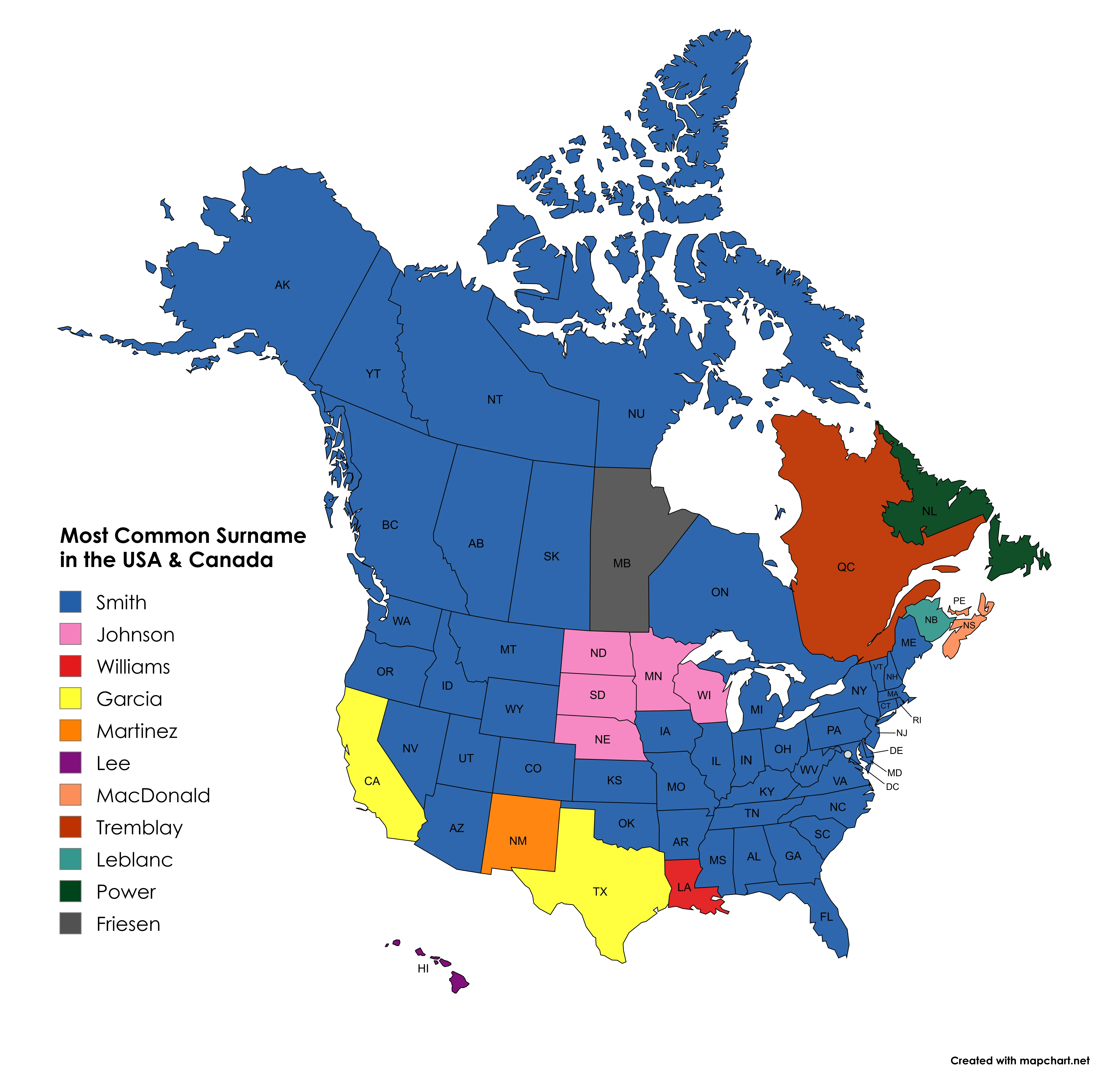Most Common Surname in the USA & Canada Map


Marcus Rodriguez
Historical Geography Expert
Marcus Rodriguez specializes in historical cartography and geographic data analysis. With a background in both history and geography, he brings unique...
Geographic Analysis
What This Map Shows
The "Most Common Surname in the USA & Canada Map" provides a visual representation of the most frequently occurring surnames across various regions in the United States and Canada. This map highlights the distribution of surnames, revealing patterns that reflect historical migration, cultural influences, and demographic trends. Understanding the prevalence of certain surnames in specific areas can offer insights into the complex tapestry of North American identity and heritage.
Deep Dive into Surnames in North America
Surnames, often referred to as family names or last names, are a crucial aspect of personal identity and play a significant role in understanding our ancestry. In both the USA and Canada, the evolution of surnames can be traced back to various cultural influences, including Indigenous populations, European settlers, and more recent immigrant communities. Interestingly, the most common surnames often serve as a reflection of historical migration patterns, regional cultures, and the blending of diverse traditions.
In the United States, the most common surname is "Smith," a name that has Anglo-Saxon roots and was traditionally associated with blacksmiths, a vital profession in early colonial times. Other prevalent surnames include "Johnson," "Williams," and "Jones," each representing a different aspect of the country's rich historical narrative. For instance, "Johnson" signifies the son of John, while "Williams" can be traced to the given name William, showcasing the patronymic naming conventions that were common in many European cultures.
In Canada, the surname landscape is quite diverse due to its multicultural population. The most common surnames include "Smith" and "Brown," but also reflect French heritage with names like "Gauthier" and "Lavoie." This diversity is a testament to Canada’s history of immigration and the blending of cultures over centuries. In fact, Canada’s approach to immigration has led to a unique surname distribution, with names from various ethnic backgrounds appearing prominently in different provinces.
What’s fascinating is how surnames can indicate geographic origins. For example, names like "Patel" are prevalent in regions with significant South Asian populations, while "Nguyen" is common in areas where Vietnamese communities have settled. This not only highlights the impact of immigration but also illustrates how cultural identities persist through generations.
Regional Analysis
When examining the map, regional differences in surname prevalence become apparent. In the Northeastern United States, for example, the surname "Smith" dominates, particularly in urban centers like New York City, reflecting the historical influx of English settlers. However, as you travel to the Midwest, surnames such as "Johnson" and "Williams" become more prominent, possibly indicating the settlement patterns during the westward expansion in the 19th century.
In Canada, the dynamics shift significantly across provinces. In Quebec, for instance, French surnames like "Lavoie" and "Boucher" are much more common, a direct reflection of the province's Francophone heritage. Moving west to British Columbia, the surname landscape changes again, showcasing a more diverse demographic with a higher representation of Asian surnames, such as "Chen" and "Kim," due to the influx of immigrants over the last few decades.
Interestingly, the Southern United States exhibits its own unique surname trends, with names like "Williams" and "Jones" frequently appearing. This can be linked to the region's historical background, including the legacy of the plantation economy and the African American experience, which has shaped the surname landscape significantly.
Significance and Impact
Understanding the distribution of surnames is not just an academic exercise; it holds real-world implications for community identity and social dynamics. For instance, knowing the most common surnames in a region can aid in genealogical research, allowing individuals to trace their family histories more effectively. Additionally, surnames can influence perceptions of ethnicity and cultural background in various social contexts, impacting everything from job opportunities to social interactions.
Current trends indicate that as immigration patterns continue to evolve, the landscape of surnames in the USA and Canada will also shift. With the rise of global migration, new surnames are becoming commonplace, reflecting the multicultural nature of society. This ongoing change invites curiosity about how future generations will navigate their identities and histories as the map of surnames continues to transform.
Overall, the "Most Common Surname in the USA & Canada Map" serves as a compelling reminder of the rich, intertwined histories that have shaped North American society. It highlights how deeply personal identities are influenced by broader patterns of migration, culture, and community, making this map not just a tool for understanding surnames but also a window into the past and future of our shared heritage.
Visualization Details
- Published
- October 26, 2025
- Views
- 6
Comments
Loading comments...